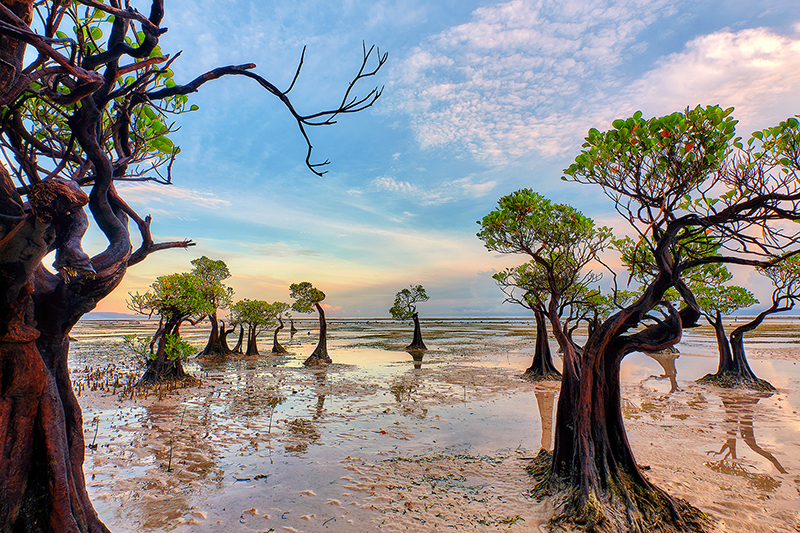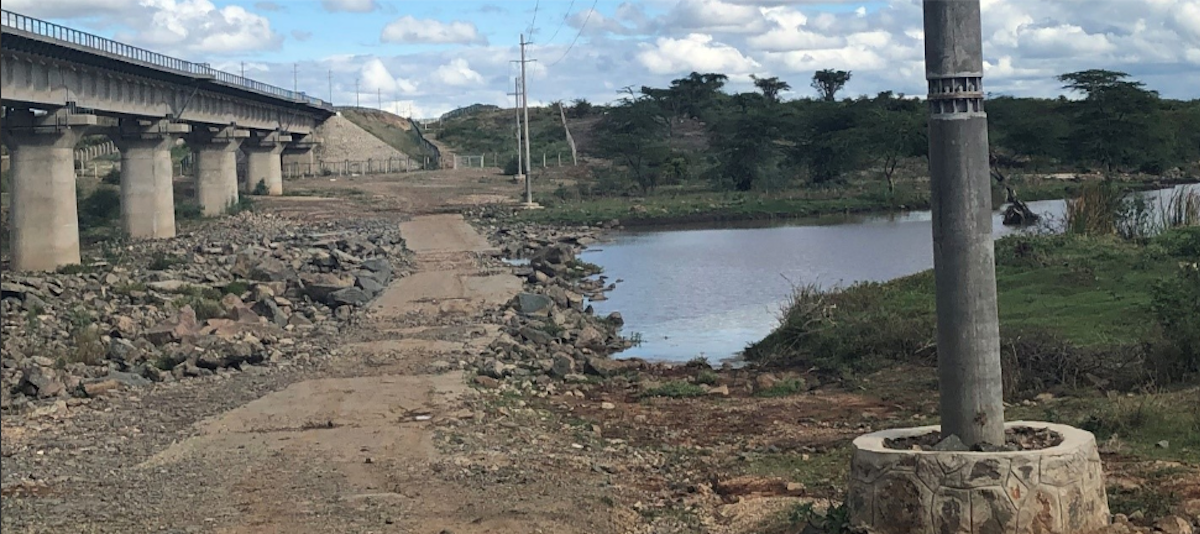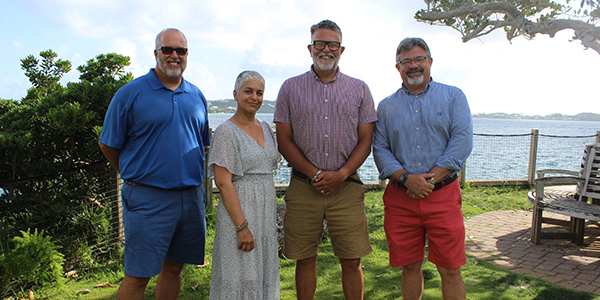FEATURED STORY THE INTERNATIONAL DAY FOR THE CONSERVATION OF THE MANGROVE ECOSYSTEM  GLOBAL – The ‘ International Day for the Conservation of the Mangrove Ecosystem’, celebrated each year on the 26 th July, aims to raise awareness of the importance of mangrove ecosystems and to promote solutions for their sustainable management and conservation. Mangrove forests are essential and productive ecosystems that provide numerous goods and services to the marine environment and local communities. These important habitats that are one of the last hunting grounds of the Bengal tiger and a refuge for countless migratory birds, mammals, and insects. This historic day commemorates Greenpeace activist Hayhow Daniel Nanoto, who died of a heart attack on the 26 th July 1998 during a massive protest to re-establish the mangrove wetlands in Muisne, Ecuador. The local community of Muisne joined forces with NGOs and the Greenpeace crew of its flagship Rainbow Warrior to dismantle an illegal shrimp pond in an attempt to restore this damaged zone back to its former state as a mangrove forest. Since Hayhow’s death, Mangrove Action Project (MAP) joined FUNDECOL of Ecuador in commemorating this date as Mangrove Action Day. As of 2015, 26 th July was declared the International Day for the Conservation of the Mangrove Ecosystem by UNESCO, also known as World Mangrove Day. “The 26th July is the day that we, communities and organizations working in defense of the mangroves, joined for the first time as little ‘Davids’ confronting a big ‘Goliath’ – the shrimp industry. That is what we must celebrate, but please, do not forget Nanoto who left his life in the mangroves of Muisne,” said Veronica of FUNDECOL, Ecuador. READ MORE AFRICA ‘Help us protect the Ankobrah mangrove forests’ – Assemblyman appeals  GHANA – The Assemblyman of the Ankobrah Electoral Area in the Western Region, Mr Isaac Morkeh Codjoe, has appealed for assistance to protect the mangrove habitats around the Ankobrah River from being destroyed for firewood and construction. Mangroves are a group of tropical trees or shrubs that grow in dense thickets or forests along tidal estuaries with exposed roots that serve as a buffer between marine and terrestrial communities by protecting shorelines from damaging winds, waves, and floods. In an interview with the Ghana News Agency (GNA) Mr Codjoe said although other conservation groups had intervened through education and awareness creation, the problem still persisted and getting out of hand. “The Assembly and other groups have tried to protect the mangrove forests around the Akobrah River for so many years, but things are not the same now. People are cutting down the trees to sell for firewood and for construction,” he said. READ MORE Kenya’s huge railway project is causing environmental damage.  KENYA – Kenya is constructing a railway line that connects the coastal port of Mombasa and the interior of the country. It is expected to terminate at Malaba, a town on the border with Uganda, and link up with other railways that are being built in East Africa. Although the actual land area affected by the railway itself is small, parts of it are raised and it cuts through a wide range of the country’s ecologically fragile and important ecosystems. Participants in our study identified that the railway line had an impact on soil, water and air contamination, during construction and operation of the line. During construction, soil was compacted and excavated. It was also moved from one location to another to erect embankments. This has many effects on the environment. Community Forest Association officials (around the coastal mangrove forests in Mombasa) observed that sediment, eroded from the rail embankments, affected streams and plants. “Not only did it affect mangroves seed development and self-germination but also blocked streams and reduced the stream size’, they said. READ MORE AMERICAS
Mangrove forest project gets boost from Aspen donation

BERMUDA – An environmental drive to create a coastal red mangrove forest on Trunk Island has been boosted by a $125,000 donation from Aspen Bermuda. Aspen will give $25,000 a year over five years to support the Bermuda Zoological Society project on the Harrington Sound island and will contribute to its educational Living Classroom programme. Colin Brown, BZS president, said: “Thanks to the generous donation from Aspen Bermuda Limited, the BZS has an opportunity to create a new red mangrove habitat on Trunk Island. “The habitat will give our education team new opportunities to teach science in exciting ways and will permit substantive and sustained educational experiences for thousands of students as they move through the Bermuda school systems.” READ MORE
World’s largest seagrass project proves ‘You can actually restore the oceans’

USA – Karen McGlathery, an environmental sciences professor at the University of Virginia, is part of a team running the largest seagrass restoration project in the world in these coastal bays — and one of the most successful. The two-decade-long project is a “blueprint for restoring and maintaining healthy ecosystems,” according to a 2020 research paper, and proof that marine habitats can be brought back to life in a way that’s self-sustaining. Over the last 20 years, supported by an army of volunteers, the project team has sown nearly 75 million seeds. Around 9,000 acres of coastal bays are now blanketed with eelgrass, which has improved water quality, increased marine biodiversity and helped mitigate climate change by capturing and storing carbon. The project, says Unsworth, “is demonstrating to the world that you can actually restore the oceans.” While plenty of projects have restored coastal habitats such as mangroves and salt marshes, he adds, few have been able to restore the ecosystems that lie beneath the surface of the water. “It’s quite fundamental what they achieved.” READ MORE
ASIA
Genome of salt-secreting mangrove species decoded by DBT

INDIA – Scientists have reported for the first time a reference-grade whole genome sequence of a highly salt-tolerant and salt-secreting true-mangrove species, avicennia marina, the Department of Biotechnology said. The genomic resources generated will pave the way for researchers to study the potential of the identified genes for developing drought and salinity tolerant varieties of important crop species of the coastal region that is significant for India with 7,500 kilometres of coastline and two major island systems, it added. Mangroves are a unique group of species found in marshy intertidal estuarine regions and survive a high degree of salinity through several adaptive mechanisms. They are a critical resource for the coastal region and are of great ecological and economic value. READ MORE
Datinakhali village battles climate crisis

BANGLADESH – Datinakhali rests on the edge of the Bangladeshi Sundarbans in the town of Shyamnagar, Satkhira. The small village is a gateway towards the great Sundarbans — one of the most beautiful places on earth, but the families eking out a living in its waters are buffeted by one problem after another. Being on the frontline of the climate crisis, rising sea levels and erosion due to the hungry storm surges claim more and more land each year in Datinakhali. Salt infiltrates the drinking water and imbues the vegetables with a sharp tang. There was no one in this village whose houses and properties didn’t wash away in the cyclones like Aila and Amphan in the past decade. Around Datinakhali, the aquaculture industry dominates the landscape, surrounded by an earthen patchwork of shrimp ponds and soft-shell crab farms. Livestock, goats and chicken-common in almost every household in rural Bangladesh is also a rare sight here. The smell of crab and fish waste permeates the hot and humid air as children run barefoot through the barren area just alongside the river. READ MORE
Mangroves, a crown jewel of Singapore’s coastline

SINGAPORE – Hundreds of millions of people in coastal communities across the tropics depend on mangrove forests for fisheries, fuel wood, medicines and coastal protection. The huge importance of mangroves is commemorated every year on Jul 26, with the United Nations’ International Day for the Conservation of the Mangrove Ecosystem. There is much to celebrate: Mangrove forests were previously considered one of the most threatened habitats on the planet, but international efforts have turned this habitat into an emerging conservation success story. READ MORE
Goa’s mangroves have unique food and medicine, need management

INDIA – Mangroves are popular as fish nurseries and nature’s defence systems. In Goa, they are a perfect setting for celebrations, crocodile worship and boat festivals even as their potential for honey, vegetables and medicinal benefits need to be explored. Making a case for comprehensive mapping of mangroves and identifying their importance in various aspects with other activists, Fr Bolmax Pereira, a botanist and priest, suggested conservation status for the Kandella candel as a state mangrove species. The submission at the recently held public hearing for the draft coastal zone plan (CZMP) was prepared by a team led by him and supervised by Goa Foundation. “Kandella candel species has discontinuous distribution along the Indian coast, but is found abundantly in Goa’s estuaries of Zuari, Mandovi and Cumbarjua,” Pereira said. READ MORE
Our Coast: Guarding Mangroves

CHINA – In 1990, the National Shankou Mangrove Ecological Nature Reserve was established in Shankou Town, Beihai City, south China’s Guangxi Zhuang Autonomous Region. Mo Jirui, who grew up in this mangrove forest, is the most senior forest ranger on the premises. Many of the trees and shrubs in the reserve have been planted by Mo, who is also an expert on the conservation techniques of different mangrove species. At the age of 66, he continues his work, guarding the mangrove forest he so much cherishes. China’s coastline stretches over 18,000 kilometers and is home to abundant marine life, such as Bryde’s whales, Chinese white dolphins and sea turtles. READ MORE
Minister’s visit to set the ball rolling for mangrove research centre in Kochi

INDIA – Fisheries Minister Saji Cherian visited the Puthuvype Fisheries Station to assess the facilities at the station before considering a proposal for setting up a world-class centre for mangrove research and development there. The fisheries station, under the Kerala University of Fisheries and Ocean Studies (Kufos), is spread over 50 acres and is home to a large collection of mangrove plants. The station is being considered as the venue for establishing a centre for research and is home to several local varieties of brackish water fishes and crabs as well as water birds that include migratory birds. A proposal had been submitted to convert the station into a world-class research centre following suggestions from a national conclave of fisheries and ocean scientists in Kochi in May, 2019. READ MORE
OCEANA
A closer look at plans for Australia’s largest prawn farm

AUSTRALIA – As Project Sea Dragon comes one step closer to lift-off, The Fish Site assesses the potential impacts – both positive and negative – that it’s likely to have on the social, economic and environmental fabric of two remote regions of Australia. Seafarms Group Limited’s newest aquaculture endeavour, Project Sea Dragon, is set to become Australia’s largest tiger prawn farming operation and one of the world’s largest prawn farms. The facility is projected to produce 150,000 tonnes of tiger prawns (Penaeus monodon) per annum when fully operational — approximately half of which will be exported overseas. Despite the move affording the project relative regulatory freedoms, the Legune coastal floodplain is a site identified by the Northern Territory Government as one of conservation significance, due to its high concentration of waterbird and shorebird species. In the wet season, the water from the catchment is flushed into the estuarine receiving environment, and this run-off transports freshwater, sediment loads and detritus that have built up during the dry season and contain nutrients that are deposited downstream. However, according to the EIA, an assessment of the area found that the project would not result in a significant impact to the “nationally important” aggregations of waterbirds or other threatened and migratory species. READ MORE Like this newsletter?
Pease consider donating to MAP to keep it going.
Giving could never be easier  | 7th annual Mangrove Photography Awards. LAST CHANCE TO ENTER! SUBMISSION DEADLINE IS JULY 26. CLICK HERE Contest NOW OPEN – Enter Now
URGENT ACTION Stop construction work on a private port In Defense of the Quilombo Boca Do Rio TAKE ACTION! Tell Sumitomo to stop building polluting coal power in Bangladesh! TAKE ACTION! Stop Adaro, Indonesia’s coal giant, from refinance its debt.
TAKE ACTION Buy a Pin – Support MAP

ACTION ALERTS Lawsuit Against Genetically Engineered Tree Solidarity Group – SIGN PETITION Tell the Japan International Cooperation Agency not to fund polluting coal – TAKE ACTION Please SIGN: keep plantations out of orangutan habitat!
TAKE ACTIONUnilever: stop destroying mangroves for convenience food! SIGN OUR PETITION
Stop plundering the oceans for industrial aquaculture! SIGN THE PETITION
Like this newsletter? Pease consider donating to MAP to keep it going. Giving could never be easier
Please see our newest video: “Restoring The Natural Mangrove Forest”
WATCH VIDEO 
Restoring The Natural Mangrove Forest
Watch movie 
Community Based Ecological Mangrove Restoration in Rufiji Delta VIEW VIDEO Video: Mangroves for the Future – A look bacK. As the latest phase of Mangroves for the Future (MFF) draws to a close, this video highlights some of the project’s most successful initiatives – from local women supporting national park management in Viet Nam to an island in the Maldives that has become a model for waste management, and everything in between. View Here WANT TO GET INVOLVED?
Follow and Join MAP!    
Like this newsletter? Pease consider donating to MAP to keep it going. Giving could never be easier 

Singing for the Sundarbans WATCH HERE Entrevista con Monica Quarto del Mangrove Action Project (Spanish language) Oye Aqui
VOLUNTEER OPPORTUNITY 
MANGROVE ISSUES Want to learn more about mangroves?
Our short presentation will give you a better understanding of the issues we are working to solve. WATCH PRESENTATION What is CBEMR? Download MAP’s 2 page CBEMR Information Sheet containing links to all MAP’s CBEMR resources – CLICK HERE
View MAP’s uploaded Videos at
MAP Video Gallery Question Your Shrimp Consumer/Markets Campaign!
WATCH VIDEO Mangroves: Guidebook to Malaysia – Click Here SHARE MAP’S VISION
CLICK HERE to watch short introductory video. Together we can work “at the roots of the sea”. Our short documentary, Reducing the Risk of Disaster through Nature-Based Solutions : Mangroves

Marvellous Mangroves Curriculum The Marvellous Mangroves Curriculum begins with a simple philosophy – getting future generations to not only learn about, but understand the importance of mangrove forests. VISIT 
The award-winning Marvellous Mangroves (MM) curriculum educates children on the importance of mangroves and their ecological functions, teaching them about modern challenges and mechanisms for sustainability. VIEW VIDEO Marvellous Mangroves Curriculum in Bangladesh – WATCH VIDEO
MARVELLOUS MANGROVES IN BRAZIL
En Portuges 
Marvellous Mangroves – A Curriculum-Based Teachers Guide.
Like this newsletter? Pease consider donating to MAP to keep it going. Giving could never be easier 
“Question Your Shrimp” Campaign Question Your Shrimp – is it really sustainable? Sign the Petition
Note to Our Readers: We strive to keep active links in our newsletter. However, due to circumstances beyond our control, occasionally links to stories may become broken. If you find a link to a story is not functioning, please cut and paste the headline into your browser search bar. In most cases you should be able to locate the original story.
Not yet a MAP News subscriber?
Click here to subscribe. 
|




























